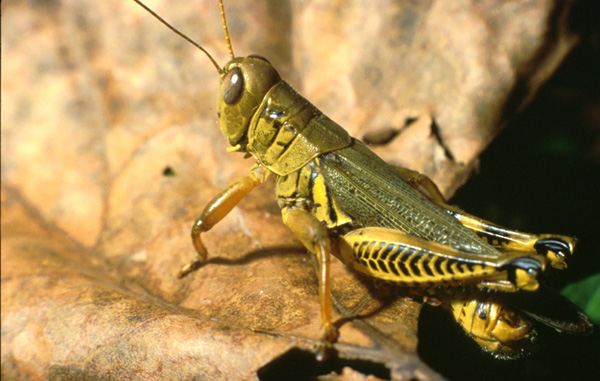
Differential grasshopper, Melanoplus differentialis, is one of the most common grasshoppers in Texas.
Grasshoppers are occasional pests of ornamental landscapes. The differential grasshopper (see image) and four other species (red-legged, migratory, two-striped, and Packard grasshoppers) cause most of the damage seen by homeowners and urban residents in Texas. Because grasshoppers require relatively large breeding grounds in which to build large populations, most severe outbreaks occur near farmland and other less disturbed areas, such as in rural communities, farmsteads, and urban fringe areas. Although grasshopper damage is difficult to completely prevent during outbreak years, homeowners can minimize their impact through the use of barriers, insecticides and landscape plants that are less prone to damage.
Biology
Generally only one generation of grasshoppers is produced each year; however cool, dry weather during the spring months and the successive emergences of different grasshopper species can result in a seemingly endless procession of these insects throughout the summer and fall months. Grasshopper eggs are generally laid during the fall and late summer in rural, non-crop landscapes, such as along ditches, fencerows, and shelter-belts, and in weedy areas. They may also be laid in crop areas after harvest, within weedy fields, and in forage areas and pastureland. Eggs usually hatch the following spring, in June and July. The development of grasshopper nymphs to the adult stage requires 40 to 60 days or more.
Adult forms of the differential grasshopper usually appear in mid-July. The adult grasshopper is the most voracious feeder, and is able to disperse over large areas due to its strong wings. The adult grasshopper is the most likely stage to invade and damage ornamental landscapes.
Control
Because residents of urban communities generally have little control over the surrounding countryside, management options for grasshoppers in urban landscapes are limited. Homeowners can protect valuable plants, to some extent, through the use of residual insecticides. Geotextile fabrics can be used as barriers to protect valuable vegetables and specimen ornamental plants. Also, landscape plants that are less attractive to grasshoppers can be used.
Recent tests have shown that insecticides containing bifenthrin (found in some Ortho® Home Defense? products) and lambda-cyhalothrin (Scimitar®) provide the fastest knockdown and longest residual control. Products containing permethrin (several manufacturers), cyfluthrin (Bayer® Advanced Lawn and Garden products), and esfenvalerate (Ortho® Bug-B-Gone) should also provide good control. Insecticides containing chlorpyrifos, diazinon and carbaryl will provide control of shorter duration.
Geotextile fabrics have found increased use among vegetable gardeners as floating row covers to protect plants. These fabrics are light enough to permit needed sunlight and air circulation to occur within plants that are covered, yet strong enough to provide a barrier to many insects. During heavy grasshopper infestations, even these barriers may be damaged by hungry grasshoppers. It may be necessary to apply insecticides (that are labeled for the plants being protected) to the fabrics before they are used to cover the plants. Some plants that require insect pollination may require hand pollination when covered by row covers. These fabrics may be obtained through some garden centers and via mail-order garden supply catalogs.
The following list of plants preferred and not-preferred by grasshoppers was developed largely by (retired) extension horticulture agents, John Cooper and Stan Lovelace, based on observations during heavy grasshopper feeding in Denton County in 1998. Additional species have been added based on reports from Master Gardeners and others. The plants listed were observed under heavy feeding pressure from differential grasshoppers. This list should be used with caution, understanding that different results may be obtained under differing conditions with different grasshopper species.
| Preferred | Slight Damage | Not Preferred | |||||||||||||||||||||||||||||||||||||||||||||||||||||||
|---|---|---|---|---|---|---|---|---|---|---|---|---|---|---|---|---|---|---|---|---|---|---|---|---|---|---|---|---|---|---|---|---|---|---|---|---|---|---|---|---|---|---|---|---|---|---|---|---|---|---|---|---|---|---|---|---|---|
|
|
|
For more information
For more information about grasshoppers see Extension leaflet E-209, Grasshoppers and Their Control. This publication, and help with additional questions about grasshoppers or other pest problems, can be obtained by contacting your county Extension office.
Author
Michael Merchant, Ph.D., Professor and Extension Urban Entomologist, Texas AgriLife Extension Service